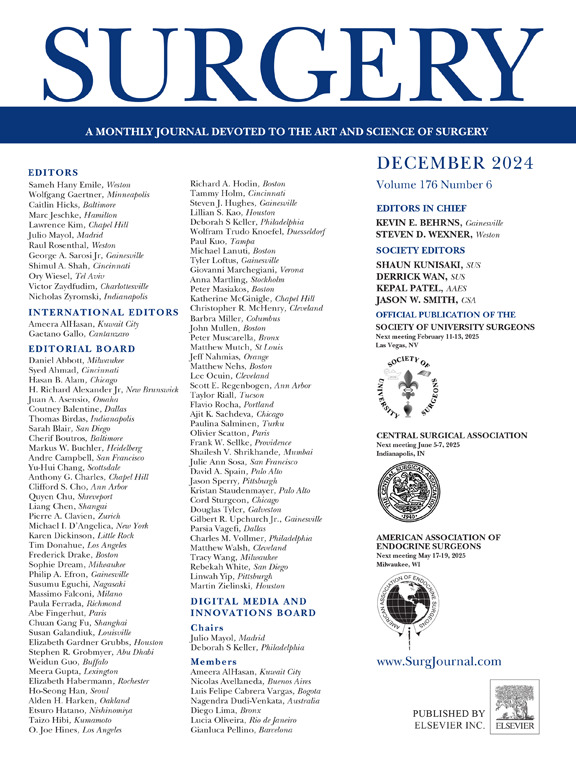State family support policies and their impact on women's representation and productivity in surgical research: A web-scraping comparative analysis
IF 3.2
2区 医学
Q1 SURGERY
引用次数: 0
Abstract
Background
Gender disparities in academic surgery persist, with women underrepresented as first authors and facing significant barriers to research productivity. Family-supportive policies, including paid family leave and reproductive rights protections, have been suggested as potential solutions to mitigate these disparities. However, their impact on women representation in surgical research has not been comprehensively evaluated.
Study Design
This cross-sectional analysis, using a web-scraping methodology, examined 198,542 first-author publications from 388 PubMed-indexed surgery journals published between 2010 and 2022. Gender differences in research output and representation were assessed across US states with and without family-supportive policies, specifically mandatory paid family leave and protective reproductive rights. We compared women representation among first authors and analyzed the average publication count for women authors, examining gender disparities at publication thresholds of 1, 2, and 5 papers.
Results
Women comprised 33.0% of all first authors, with representation decreasing at higher publication thresholds. States with paid family leave showed higher women representation among first authors compared with non–paid family leave states (34.2% vs 32.3%; P < .001), and similarly, protective reproductive rights states had more women representation than restrictive states (33.9% vs 32.0%; P < .001). Among authors with 5 or more publications, women represented 25.1% in paid family leave states versus 22.6% in non–paid family leave states (P = .005), and 24.6% in reproductive rights states versus 22.3% in restrictive states (P = .010). Women in states with these policies also saw significantly higher average publication counts (P < .001).
Conclusion
State-level paid family leave and reproductive rights policies are associated with improved women representation and reduced gender disparities in surgical research. Our results indicate a statistically significant association between family-supportive policies and increased women's authorship, suggesting that such policies may play a role in shaping the academic trajectories of women in surgery.
国家家庭支持政策及其对妇女在外科研究中的代表性和生产力的影响:一个网络抓取比较分析
学术外科领域的性别差异仍然存在,女性作为第一作者的比例不足,并且在研究效率方面面临重大障碍。有人建议采取支持家庭的政策,包括带薪家庭假和生殖权利保护,作为缓解这些差距的潜在解决办法。然而,它们对外科研究中女性代表性的影响尚未得到全面评估。这项横断面分析使用网络抓取方法,研究了2010年至2022年间发表的388份pubmed索引外科期刊中的198,542份第一作者出版物。研究人员评估了美国各州在研究产出和代表性方面的性别差异,这些州有和没有支持家庭的政策,特别是强制性带薪家庭假和保护性生殖权利。我们比较了女性在第一作者中的代表性,分析了女性作者的平均发表数,在1篇、2篇和5篇论文的发表阈值下检查了性别差异。结果女性占所有第一作者的33.0%,随着发表阈值的提高,女性比例下降。有带薪家庭假的州与没有带薪家庭假的州相比,第一作者中的女性比例更高(34.2% vs 32.3%;P & lt;.001),同样,保护生育权的州比限制生育权的州有更多的妇女代表(33.9% vs 32.0%;P & lt;措施)。在发表5篇或更多文章的作者中,女性在带薪家庭假州占25.1%,在无薪家庭假州占22.6% (P = 0.005),在生育权州占24.6%,在限制性州占22.3% (P = 0.010)。在有这些政策的州,女性的平均出版数量也显著增加(P <;措施)。结论国家级带薪家事假和生殖权利政策与提高外科研究中女性代表性和减少性别差异有关。我们的研究结果表明,在统计上,家庭支持政策与增加女性作者之间存在显著关联,这表明此类政策可能在塑造外科女性的学术轨迹方面发挥作用。
本文章由计算机程序翻译,如有差异,请以英文原文为准。
求助全文
约1分钟内获得全文
求助全文
来源期刊

Surgery
医学-外科
CiteScore
5.40
自引率
5.30%
发文量
687
审稿时长
64 days
期刊介绍:
For 66 years, Surgery has published practical, authoritative information about procedures, clinical advances, and major trends shaping general surgery. Each issue features original scientific contributions and clinical reports. Peer-reviewed articles cover topics in oncology, trauma, gastrointestinal, vascular, and transplantation surgery. The journal also publishes papers from the meetings of its sponsoring societies, the Society of University Surgeons, the Central Surgical Association, and the American Association of Endocrine Surgeons.
 求助内容:
求助内容: 应助结果提醒方式:
应助结果提醒方式:


